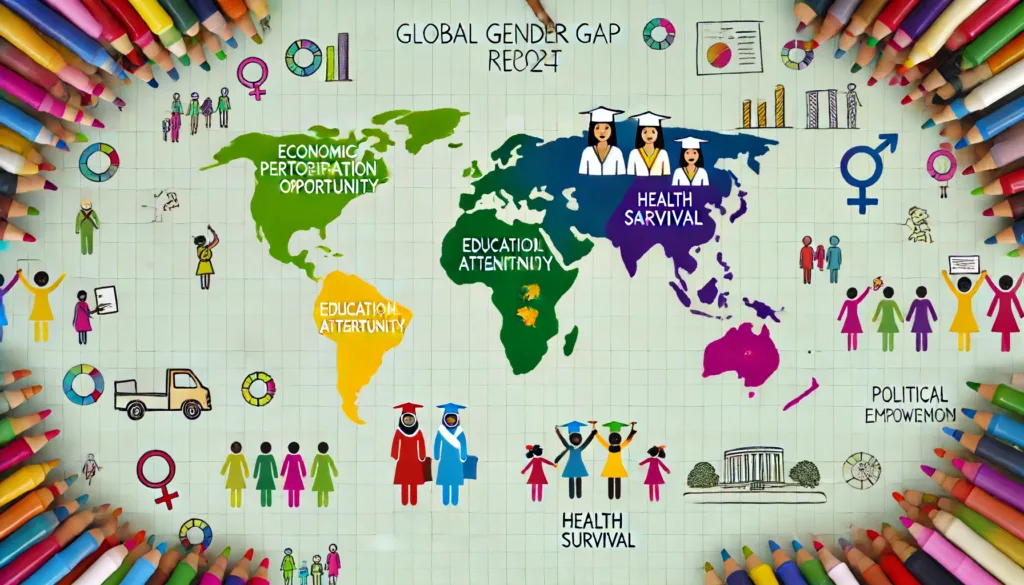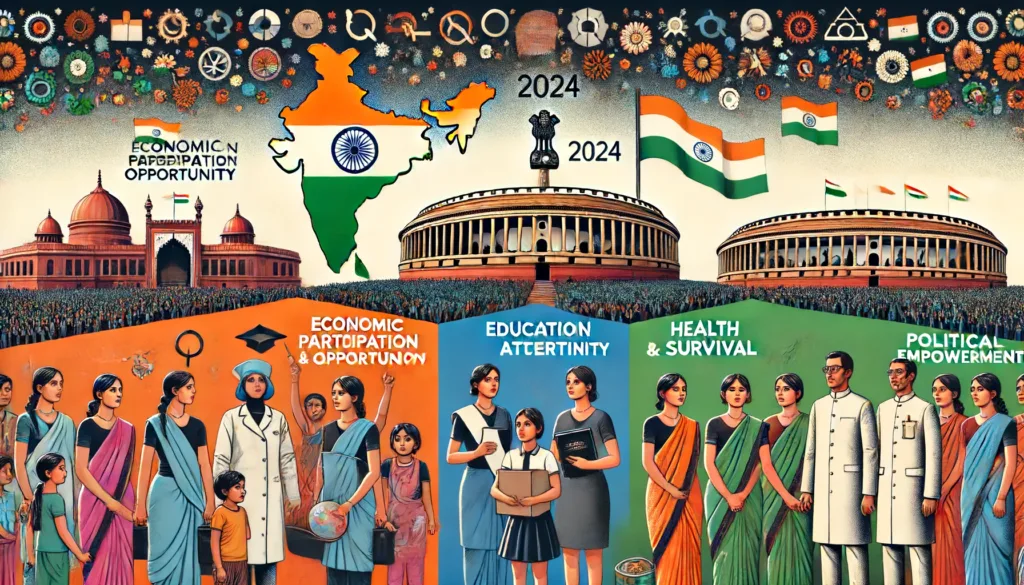Global Gender Gap Report:
In 146 countries around the world, The World Economic Forum’s Global Gender Gap Report 2024 provides insight full analysis of Gender Parity. This publication has been monitoring gender differences since 2006; it evaluates progression in 4 critical dimensions: Economic Participation and Opportunity; Educational Attainment; Health and Survival rate; Political Empowerment respectively. Last year’s findings emphasized the perpetuity of obstacles as well as marginal improvements in closing the global gender gap. Of particular note is India whose position at 129 reflects serious disparities that still need to be addressed.

Table of Contents
Global Overview:
Among the above dimensions, The Global Gender Gap Index is used to measure current situations and changes in gender equality since it was launched in 2006 elucidating that total world’s gender parity is expected by 2138 with a slight improvement from past years. Yet, this sluggish pace exposes more need for significant targeted strategies in order to bridge those gaps.

Economic Participation and Opportunity:
Economic Participation and Opportunity remain one of the most difficult challenges worldwide, with ample quantities of barriers women face for entrance into employment . On the other hand there still exist gaps in salary scales; leadership structures as well as participation rates which call for policies promoting equal pay rates besides supporting feministic initiatives on leadership promotion, respectively .
Educational Attainment:
On the other hand, education attainment index records near parity in many countries especially lower levels such as primary or secondary although discrepancy still holds in higher levels even including certain fields of STEM (Science, Technology, Engineering, Mathematics) education where females’ rate is relatively low as compared to their male counterparts.
Health and Survival:
This same report notes that health outcomes have reached an impressive level of balance worldwide while some issues like maternal mortality rates linger despite improvements made so far globally . Despite remarkable gains being made within the health sector much still remains unsolved especially concerning maternal deaths and lack of necessary healthcare services at community levels in different regions
Political Empowerment:
Women’s representation in political decision-making processes shows the most significant gap among other dimensions. Quotas and other initiatives have advanced some national scores but they are still insignificant and ineffective on a global scale.
Models like Pradhan Mantri Matru Vandana Yojana which offer financial support to mothers in return of clinically delivered babes are good but need to cover more areas urgently. In fact, if culture-related barriers could be dissolved today then the life-expectancy of an average Indian woman or a girl child would be the same or higher than Japan’s in years to come.
Political Participation:
India still experiences major challenges associated with this as well. In fact, women are poorly represented politically since they hold 14.4% of parliamentary positions and 10% ministerial posts only. Despite the quotas that exist for them to be part of local councils, their presence in these offices is still minimal.
Cultural impediments coupled with absence of adequate
support structures and male bias among political parties have resulted in
under-representation of women in politics. These are essential programs
designed to enhance the quality of women as leaders which require women
leaders’ coaching on issues related to leadership; this way more women will
features prominently in deciding installations.

Key Strategies to Improve:
India should adopt a multi-faceted approach to address these problems and achieve gender equality:
Implementation of economic policies:
Gender responsive economic policies that enhance equality in pay between men and women; promote women entrepreneurs and creation of more job opportunities for women. Additionally, affordable childcare facilities and flexible work arrangements could increase the number of females in employment.
Reforms in Education:
Increased girl child education especially in rural areas and encouraging them to venture into STEM (Science, Technology, Engineering, Mathematics) subjects. This can be done by offering scholarships as well as using monetary motivation to reduce school dropout rates among girls who wish further their education.
Accessible Healthcare:
Investing more in healthcare infrastructures and services for pregnant mothers who live in remote regions within the country. Specific health programs or campaigns should be initiated like improving maternal health care system or raising awareness on malnutrition situation.
Political Participation:
Enhancing women’s numerical presence in different political positions by putting in place affirmative action measures including affirmative action on support and creation of an enabling environment for women leaders by training them as well as offering mentorship programs. Also, having political parties with feminist orientation will help erode negative sentiments that impede many from contesting for the political seats.
Conclusion:
The latest @wef Global Gender Gap Report was published today.
— World Economic Forum (@wef) June 12, 2024
It shows that parity in #labour-force participation is improving, rising to 65.7% from a pandemic low of 62.3%.
And, @LinkedIn data shows that #women's #workforce representation remains below men's in almost every… pic.twitter.com/uhcvBiRhzV
India has made tremendous strides in some areas as per “Global Gender Gap Report 2024” while the same report identifies persistent challenges within certain sectors that must be addressed before any form of gender balance can be achieved. Be reminded that India occupies the 129th position out of 146 nations on earth. By concentrating on comprehensive policy options, community involvement plus deliberate actions; India would walk towards closure of this canyon and an equal society would prevail.
For more detailed information, the full report can be accessed [here]


1 thought on “Global Gender Gap Report 2024: A Deep Dive into the Progress and Challenges of India”